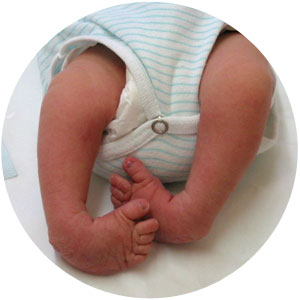Clubfoot is the most common congenital foot deformity.

This deformity is corrected with the Ponseti method, a minimally invasive treatment that was developed by the Spanish-American orthopedic surgeon Dr. Ignacio Ponseti.

Treatment is usually started within the first 3 weeks after birth but can be delayed up to 3 months under special circumstances. During treatment, the foot is gently manipulated and stretched and an above-the-knee cast is then applied. The tendons and ligaments are thereby gently stretched, and the bones can remodel until the next cast change is performed. Casts are usually changed once a week. Approximately four to six casts are necessary to correct all components of the deformity except for the equinus deformity (foot pointing down), which results from shortening and contracture of the Achilles tendon.
Percutaneous Tendo-Achilles Tenotomy (pTAT)
In approximately 90% of cases, tenotomy of the Achilles tendon is necessary after casting to complete the correction. The Achilles tendon is cut through a tiny incision with the patient under short-term general anesthesia, and the last cast is applied in the fully corrected position. That cast is removed after 3 weeks.
Because of the enormous healing potential in newborns, the tendon heals completely within the 3 weeks, but in an elongated (lengthened) position.

Foot Abduction Brace (FAB)
Clubfoot tends to recur (come back), especially during the first 3 to 4 years of life. Therefore, after the last cast is removed, a special brace is used to prevent recurrence of the deformity. The brace consists of two shoes connected with a bar that keeps the foot abducted (turned outward). The brace is especially important to maintain the correction. If no brace is used or if the brace is insufficient, the clubfoot deformity recurs in more than 70% of cases.
The braces are used for 22 hours during the first 3 months after removal of the last cast. At that time, the children are usually 3 to 6 months of age, and activity and mobility are hardly influenced by the brace. Afterward, the time in the brace is gradually reduced so that when the babies start to walk, the brace is used only for nights and naps. The developmental milestone of walking without support has been found to be not delayed or only mildly delayed (maximum, 2 months) compared with non-affected children not wearing a brace.

This method of treatment has proved highly superior compared with more invasive surgical treatment. It is gentler and provides better functional long-term outcome compared with more invasive surgical treatment, which is associated with scarring, fibrosis, and early joint degeneration.
The Ponseti method combined with correct bracing provides long-lasting good correction. Only approximately 15% to 20% of children need minor soft tissue surgery at the age of 4 to 7 years to correct mild dynamic recurrence. During this surgery, the anterior tibialis tendon is moved from the inner side of the foot to the outer side to improve muscle balance (anterior tibialis tendon transfer [ATTT] surgery). The probability of need for this procedure depends on the quality of initial treatment, brace wear, and initial severity of the clubfoot deformity.
Even more severe recurrence can be treated effectively with a tibialis anterior tendon transfer, sometimes combined with preoperative casting and/or percutaneous Achilles tendon lengthening.





